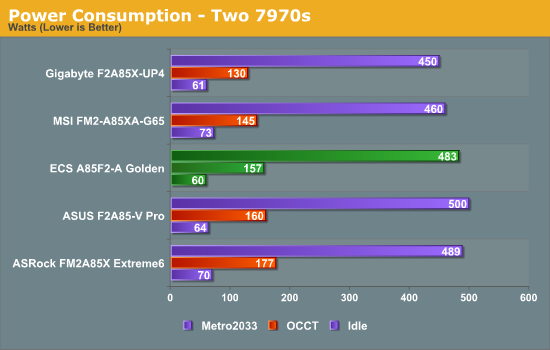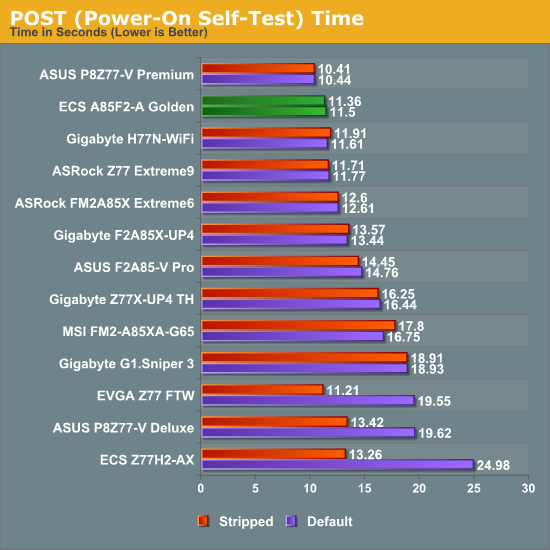ECS A85F2-A Golden Review: All That Glitters
by Ian Cutress on January 12, 2013 11:30 AM EST- Posted in
- Motherboards
- ECS
- FM2
- A85X
Many thanks to...
We must thank the following companies for kindly donating hardware for our test bed:
OCZ for donating the 1250W Gold Power Supply and USB testing SSD
Micron for donating our SATA testing SSD
G.Skill for donating our memory kits
ASUS for donating AMD GPUs and some IO Testing kit
ECS for donating NVIDIA GPUs
Test Setup
| Test Setup | |
| Processor |
AMD Trinity A10-4800K APU 2 Modules, 4 Threads, 3.8 GHz (4.2 GHz Turbo) |
| Motherboards |
ASUS F2A85-V Pro ASRock FM2A85X Extreme6 MSI FM2-A85XA-G65 Gigabyte F2A85X-UP4 ECS A85F2-A Golden |
| Cooling | ThermalRight Copper TRUE |
| Power Supply |
OCZ 1250W Gold ZX Series Rosewill SilentNight 500W Platinum PSU |
| Memory | G.Skill TridentX 4x4 GB DDR3-2400 9-11-11 Kit |
| Memory Settings | 2133 9-11-11 (or as close to it) |
| Video Cards |
ASUS HD7970 3GB ECS GTX 580 1536MB |
| Video Drivers |
Catalyst 12.3 NVIDIA Drivers 296.10 WHQL |
| Hard Drive | Micron RealSSD C300 256GB |
| Optical Drive | LG GH22NS50 |
| Case | Open Test Bed - DimasTech V2.5 Easy |
| Operating System | Windows 7 64-bit |
| USB 2/3 Testing | OCZ Vertex 3 240GB with SATA->USB Adaptor |
Power Consumption
Power consumption was tested on the system as a whole with a wall meter connected to the OCZ 1250W power supply, while in a dual 7970 GPU configuration. This power supply is Gold rated, and as I am in the UK on a 230-240 V supply, leads to ~75% efficiency > 50W, and 90%+ efficiency at 250W, which is suitable for both idle and multi-GPU loading. This method of power reading allows us to compare the power management of the UEFI and the board to supply components with power under load, and includes typical PSU losses due to efficiency. These are the real world values that consumers may expect from a typical system (minus the monitor) using this motherboard.
While this method for power measurement may not be ideal, and you feel these numbers are not representative due to the high wattage power supply being used (we use the same PSU to remain consistent over a series of reviews, and the fact that some boards on our test bed get tested with three or four high powered GPUs), the important point to take away is the relationship between the numbers. These boards are all under the same conditions, and thus the differences between them should be easy to spot.

In our setup, the ECS board has the lowest power consumption for idle, and is middle of the pack in both OCCT and dual 7970 loading.
Non-Windows 8 POST Time
Different motherboards have different POST sequences before an operating system is initialized. A lot of this is dependent on the board itself, and POST boot time is determined by the controllers on board (and the sequence of how those extras are organized). As part of our testing, we are now going to look at the POST Boot Time - this is the time from pressing the ON button on the computer to when Windows 7 starts loading. (We discount Windows loading as it is highly variable given Windows specific features.) These results are subject to human error, so please allow +/- 1 second in these results.

A good result for ECS in POST timing, especially when compared to the previous ECS boards we have tested. The A85F2-A Golden also hits under the 12 second mark.










40 Comments
View All Comments
ForeverAlone - Sunday, January 13, 2013 - link
Why so much power and so many slots/plugs on such an underpowered chipset?You'll never need to crossfire/SLI graphics cards with a CPU as weak as the A10-5800K.
Oscarcharliezulu - Sunday, January 13, 2013 - link
This has got to be the most poorly penned review I've read in a while. I reads mostly like a cut and paste jumble. You repeat yourself constantly. The grammar makes my brain hurt. Your assumptions about what "golden" represents is just space filler. For a moment I thought I was reading a bad auto-translate. Lastly, admitting you look around the web at other opinions and I now am not sure if this review is your opinion or some kind of reference to what other people have said. Please do over. D-.IanCutress - Sunday, January 13, 2013 - link
I do admit that sometimes my British idiosyncrasies come through more on some reviews than others, but it's not something I should apologize for. It did get a thorough triple check before going live, as do all my reviews. If there is something that completely boggles the mind, please feel free to email me for clarification.Regarding space filler, my review is meant to cater for a large percentage of the potential readership, and thus explaining design philosophy to those not accustomed to it is part of the package.
As for looking at other reviews and such, I would be a poor academic researcher if I did not find reference and justification for the results and final opinions of the board. To go in blind would be completely remiss, especially if I come across a fringe issue, or fail to come across a significant issue because I do not specifically test for it. I am a strong advocate in researching a topic before discussing it, especially in such a public facing publication such as AnandTech.
Ian
JonnyDough - Sunday, January 13, 2013 - link
This is actually one of the sharpest boards I have ever seen. As for the gold coated rear ports, I'm not sure if those are necessary, but if the price is right I wouldn't be complaining. Very ooglable! :)lordcheeto - Monday, January 14, 2013 - link
You should review the Biostar Hi-Fi A85W. That's what I have, and it looks good and performs good. Not sure how it stacks up against the boards you have tested, but I think it will do well.http://www.newegg.com/Product/Product.aspx?Item=N8...
sudz - Monday, January 14, 2013 - link
(though on a board this side I would prefer at least five).This size?
Rick83 - Monday, January 14, 2013 - link
out of the box?Back in the Athlon days, main board makers were using this trick to gain a few points in benchmarks, but thankfully it gradually disappeared again.
Now many different main boards hit the market, that overclock CPUs out of the box. This is not acceptable in my book, as I want all components in my system to play fair with one another, and adhere to the well known specs.
This kind of fudging around for a few percent of performance in some computation benchmarks, that don't even reflect real world gains, should be harshly judged.
After reading this, I stopped reading the rest of the review.
One other note. As you write scientific articles, why do you not preface your articles with an abstract? I think this would increase reading efficiency. If the main strong and weak points, as well as the verdict can be resumed on the front page, then a lot of time reading non-essential information can be used otherwise.
CeriseCogburn - Monday, January 14, 2013 - link
ECS is plenty big, and has a lot of good boards toward the cheaper end at all levels.The problem here is AMD and it's crap. The overclock page is embarrassing.
Another unstable piece of amd centered junk.
dgingeri - Monday, January 14, 2013 - link
Sorry, after my past experiences, no matter how nice you find this board and no matter how inexpensive it is, I am not ever going to buy ECS hardware. I had a motherboard that was bad out of the box, returned it for warranty replacement, got 3 used ones in a row, including one with the socket lever broken, that were also non-functional over the course of 3 months, and then declared the board was no longer under warranty because it was beyond 90 days. (This was way back in the socket 5 days.) I swore off them then and have never bought another one, in nearly 20 years.Not gonna happen. I won't trust them again.
ggathagan - Monday, January 14, 2013 - link
Not particularly a fan of ECS, but I think 20 years is long enough to hold a grudge.It would be a surprise if 80% of the ECS employees in 1991 are still working there.
:)